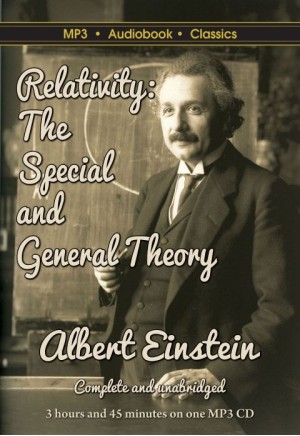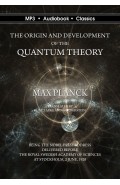| Track | Chapter | Length |
| 01 | 00 Preface - Relativity | 2:00 |
| 02 | 01. Physical Meaning of Geometrical Propositions | 5:24 |
| 03 | 02. The System of Co-ordinates | 6:25 |
| 04 | 03. Space and Time in Classical Mechanics | 3:44 |
| 05 | 04. The Galileian System of Co-ordinates | 1:56 |
| 06 | 05. The Principle of Relativity (in the Restricted Sense) | 7:03 |
| 07 | 06. The Theorem of the Addition of Velocities employed in Classical Mechanics | 2:04 |
| 08 | 07. The Apparent Incompatability of the Law of Propagation of Light with the Principle of Relativity | 6:37 |
| 09 | 08. On the Idea of Time in Physics | 8:16 |
| 10 | 09. The Relativity of Simultaneity | 5:58 |
| 11 | 10. On the Relativity of the Conception of Distance | 3:06 |
| 12 | 11. The Lorentz Transformation | 9:17 |
| 13 | 12. The Behaviour of Measuring-Rods and Clocks in Motion | 5:12 |
| 14 | 13. Theorem of the Addition of Velocities. The Experiment of Fizeau | 7:48 |
| 15 | 14. The Hueristic Value of the Theory of Relativity | 2:59 |
| 16 | 15. General Results of the Theory | 8:44 |
| 17 | 16. Experience and the Special Theory of Relativity | 9:08 |
| 18 | 17. Minkowski's Four-dimensial Space | 5:40 |
| 19 | 18. Special and General Principle of Relativity | 6:42 |
| 20 | 19. The Gravitational Field | 5:15 |
| 21 | 20. The Equality of Inertial and Gravitational Mass as an Argument for the General Postulate of Relativity | 8:10 |
| 22 | 21. In What Respects are the Foundations of Classical Mechanics and of the Special Theory of Relativity Unsatisfactory? | 4:29 |
| 23 | 22. A Few Inferences from the General Principle of Relativity | 8:51 |
| 24 | 23. Behaviour of Clocks and Measuring-Rods on a Rotating Body of Reference | 8:07 |
| 25 | 24. Euclidean and non-Euclidean Continuum | 6:59 |
| 26 | 25. Gaussian Co-ordinates | 7:29 |
| 27 | 26. The Space-Time Continuum of the Speical Theory of Relativity | 4:14 |
| 28 | 27. The Space-Time Continuum of the General Theory of Relativity is Not a Eculidean Continuum | 6:49 |
| 29 | 28. Exact Formulation of the General Principle of Relativity | 6:21 |
| 30 | 29. The Solution of the Problem of Gravitation on the Basis of the | 8:49 |
| 31 | 30. Cosmological Difficulties of Netwon's Theory | 4:55 |
| 32 | 31. The Possibility of a "Finite" and yet "Unbounded" Universe | 10:54 |
| 33 | 32. The Structure of Space According to the General Theory of Relativity | 4:08 |
| 34 | 12 - Appendix III - Relativity | 21:12 |
Notes
Running Time: 3 hours 45 minutes
Read by: Multiple readers
Book Coordinator: Kelly Bescherer
Meta Coordinator: Anita Roy Dobbs
Artwork
Cover: Photograph of Albert Einstein during a lecture in Vienna in 1921 by Ferdinand Schmutzer (1870–1928).
DVD Inset: Photograph of Albert Einstein by Oren Jack Turner, 1947.
DVD insert: Photograph of Albert Einstein by Photograph by Oren Jack Turner, Princeton, N.J. Copyrighted 1947, copyright not renewed
Recordings
These recordings were made using the author’s original published work, which is in the public domain. The readings were recorded by members and volunteers of Librivox.org, which has generously made the recordings available to the public domain. The audio files have been lightly edited and have been engineered using professional audio tools for maximum sonic quality. While Librivox condones the sale and distribution of these recordings, it is not associated with the management or operations of MP3 Audiobook Classics.
- Download and read the eBook at Gutenberg.org
- Download a PDF datasheet
- Read the review by Jennifer Ouellette of two new books on modern physics, ‘The Universe in Your Hand’ and ‘Seven Brief Lessons on Physics’, in the New York Times Book Review Sunday, April 24, 1016
The image is popular and general: A young man sits under an apple tree. An apple falls, strikes him and sets him on a course to receive those epiphanies, eureka moments, in which he deduces how the physical world works. The young man was Isaac Newton and the consequent laws are known as Newtonian physics. Move ahead two hundred years and the second image, though less well known, is of another young man with unruly hair, sitting on a hillside in Germany not far from the patent office where he worked. There Albert Einstein received his own epiphany, followed by several eureka moments, from which he deduced those laws of physics, now termed the Theory of Relativity, a theory that superseded Newton’s 200 year old theories of mechanics, and, in no small part, ushered in the Modern Era. The Theory of Relativity, is actually comprised of two theories: special relativity and general relativity. The concepts introduced in these two theories are three-fold: (1) The measurement of certain quantities is dependent upon the speed of the observer; (2) Space and time (“spacetime”) should be considered in relation to one another; and (3) The speed of light is, nonetheless, an absolute constant, invariant and the same for all observers. In any construct that allows for the relative nature of relationships, the observer must seek out the sole constant on which all relationships depend for their accurate expression. Einstein found it in the speed of light, and from that constant looked anew at the behavior of the smallest elements of matter (Special Relativity, 1905), as well as the projected behavior of an infinite cosmos (General Relativity, 1916). (Summary by Michael Hogan)
Play sample:
Download a PDF datasheet
| Item Info | |
| EAN - DVD case | 0684758936523 |
| EAN - CD jacket | 0687700170143 |
| Media | MP3 CD |
| Package | DVD Case |
| Author | Albert Einstein (1879 - 1955) |
| Translator | Robert W. Lawson (1890 - 1960) |
| Year | Special Relativity - 1905, General Relativity - 1916 |
| Recording | |
| Read by | Multiple readers |
| Length | 3 hours 45 minutes |
| Type of Reading | Collaborative |
Relativity: The Special and General Theory
- Author: Albert Einstein
- Product Code: DB-1072
- Availability: In Stock
-
$9.99
Available Options
Related Products
The Atomic Bombings of Hiroshima and Nagasaki
In August, 1945 the United States dropped atomic bombs on the cities of Hiroshima and Nagasaki. ..
$9.99
The Flying Saucers Are Real
The Flying Saucers Are Real by Donald Keyhoe was a breakthrough bestseller that was the first seriou..
$9.99
The Origin and Development of the Quantum Theory
Quantum theory was formulated by German physicist Max Planck while seeking the reason that radiation..
$7.99










